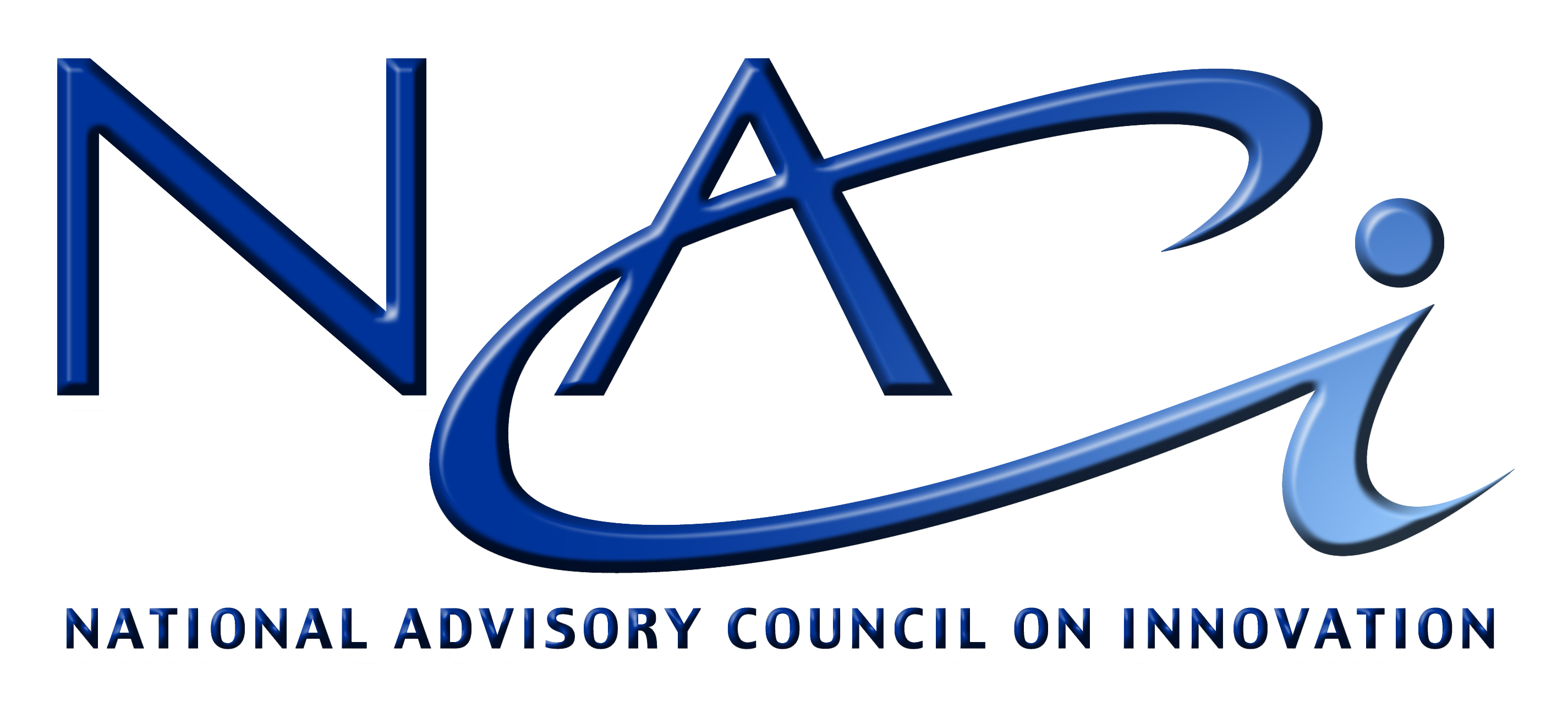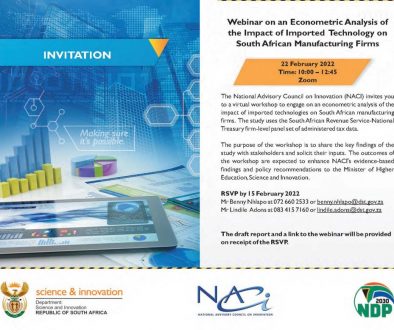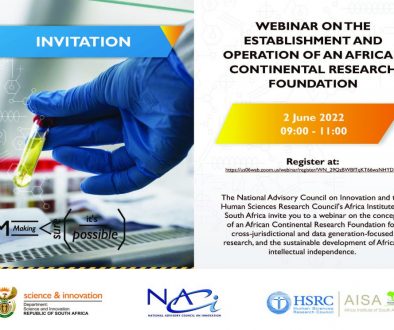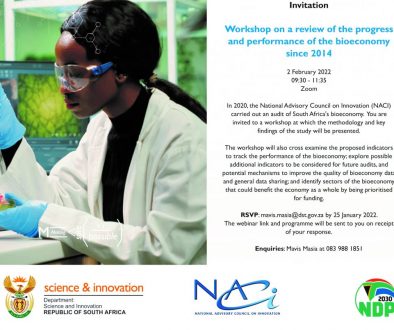NACI – INNO4DEV Workshop
Real Experiences of Industries and Businesses on Innovation for Development with Potential for Wider Adoption
With support from the Developmental Bank of Southern Africa (DBSA), Innovation for Development (INNO4DEV) subcommittee of the National Advisory Council on Innovation (NACI) hosted a workshop on Friday 29 January 2010 at the DBSA. The purpose of the workshop was to enable various organisations such as mining, chemical, financial, information and communication technology (ICT) and other relevant industries to come and share their real experiences of working with and improving lives of the grassroots communities through application of technological and non-technological innovations. The objectives of the workshop were to identify:
- Real examples of successes made through application of technological and non-technological innovations with potential for roll-out.
- Challenges to innovations and strategies applied or planned to address those challenges.
INTRODUCTORY REMARKS
In his introduction, the chairperson of INNO4DEV subcommittee, Prof Francis Petersen, thanked the DBSA for offering a venue, and the DG of Department of Science and Technology (DST), Dr Phil Mjwara, speakers and participants for attending the workshop. He pointed out that INNO4DEV was established to specifically redress social challenges facing the neglected grassroots communities in order to uplift them out of poverty through the application of innovations. He then reiterated that the aim of the workshop was to look at the real experiences of industry and business sectors and facilitate sharing of knowledge on the effectiveness of their projects that were intended to address challenges relating to poverty. Finally, he said that the aforementioned sectors would share their experiences in order to stimulate the discussion which was expected to yield recommendations to be used as a basis for the ministerial advice.
PRESENTATIONS
Five presentations were delivered by the DST, JMS Consulting, Chamber of Mines, Sasol and Tshumisano Trust to set the scene for the workshop and the following represent high level summaries of those presentations. Several project examples demonstrated how poverty and unemployment could be addressed and those are outlined below: Sustainable Livelihoods Programme (DST) Presentation by the DST reflected on some sustainable livelihoods projects that were intended to address poverty and unemployment. About 683 jobs were created as a result of projects listed below:
- Wireless Mesh Network Technology giving a broadband connectivity to rural villages and 15 small, medium and micro enterprises (SMMEs) have been created from this project
- Aquaculture (marine and freshwater)
- Agroprocessing to uplift resource poor farmers
- Essential oil herbs
- Herbal medicines with medicinal properties
- Risk and vulnerability project on climate change to give early warning to resource poor farmers
- A new initiative, Community University Partnerships (CUPS), situated at a number of universities to facilitate engagement with end-users around design of innovations tailor-made to address their challenges was also being piloted at four rural-based universities (Fort Hare, Limpopo, Venda and Zululand). The initiative is not yet operational.
It was acknowledged that establishing partnerships to advance DST’s sustainable livelihood projects was a big challenge. However, there is an opportunity for DST to forge partnership with SABC in order to ensure information on those projects was made available to public. In addition, DST is discussing with three Offices of the Premier in order to broaden partnership with local government. Facilitation of widespread adoption of beneficial technology and practices – Achievement of broad based innovation (JMS Consulting) The presentation demonstrated how work and experience of mining industry could facilitate widespread adoption of technology in relation to occupational health and safety. A model detailing steps on how to facilitate adoption of technology was presented. Steps used included the following:
- Management orientation as a foundation on which incentives and climate were created to enable innovative activity
- Identification of processes that were built into total process of leading practice
It was pointed out that the model used to encourage adoption of technology would terminate the process to develop a climate for innovation only after the mines have adopted the process. Clarity was also made that the role of the model was to effectively roll-out existing inventions and spread innovative practices not adopted by industry. However a concern was raised that the model presented was theoretical with no demonstration of practical examples. Coaltech research (Chamber of Mines) Chamber of Mines delivered a presentation that covered projects such as coal processing, water treatment and irrigation. The concern in the presentation was that there was no clear interface with communities residing around the mines. But it was pointed out that purpose of the projects was to assist communities in sustainable farming and livelihoods by using rehabilitated mine soil and water. Presentation went on to indicate that coaltech research used rehabilitated mine soil to grow crops and for cattle grazing while untreated mine water was used for crop irrigation. Real experiences of industries and businesses on innovation for development (SASOL) SASOL presentation mentioned some examples of innovations that were geared to address needs of grassroots communities:
- Mosquito net treated with insecticide to reduce malaria deaths
- Renewable ethanol gel with the following attributes:
- No spread when spilled (safety feature)
- Smokeless and no soot when burning
- Not toxic
- Aerosol paraffin gas stove and attributes (at prototype stage):
- Cheaper than traditional stoves that use illuminating paraffin (IP)
- It uses IP stored in a canister (safety feature)
- It has created new business opportunity in the form of SMMEs through sale of IP by local communities
- Potential for application in water geysers and heaters
SASOL was commended for what it had done so far with reference to the above initiatives but it was suggested that such innovations should be made known by the public. It was also pointed out that SASOL accommodates concepts (innovations from grassroots communities) and develop them using input from researchers and developers at SASOL ChemCity. An overview (TSHUMISANO) Presentation outlined in detail the role of Tshumisano which is to intervene at the level of technology transfer from higher education institutions and government agencies to individuals and SMMEs and its main mandate is:
- Testing and analysing technologies (68%)
- R& D, prototyping, product development, etc (32%).
Some of the innovations supported by Tshumisano include the following:
- Development of light aircraft engine
- Technology interventions relating to clothing and textile
DISCUSSION AND CONCLUSIONS
Although there was no clear evidence of interface between innovations and (potential) recipient grassroots communities in most presentations but there were examples of innovations with potential for roll-out. Therefore the discussion was on how to replicate the existing innovations and it led to the following suggestions:
- Use of open innovation that is inclusive.
- NACI to cater for demand side of innovations by involving grassroots communities to allow them to define parameters and identify solutions that relate to their needs
- A need to address challenges that impede roll-out of innovations
Finally, the following were concluded:
- Communities and youth to be involved in the discussions of this nature
- Networking, collaboration and cooperation between organisations and entities involved in innovation and development were deemed important in terms of maximising efforts.
- Industries’ engagement with grassroots communities yielded good lessons.



